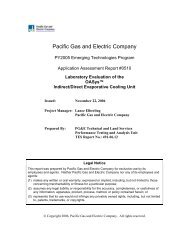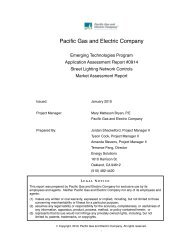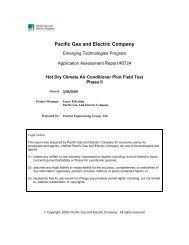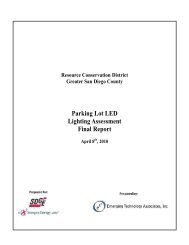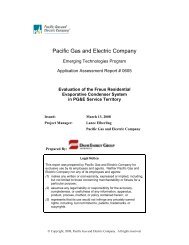High Efficiency Office: Low Ambient/ Task Lighting Pilot Project
High Efficiency Office: Low Ambient/ Task Lighting Pilot Project
High Efficiency Office: Low Ambient/ Task Lighting Pilot Project
Create successful ePaper yourself
Turn your PDF publications into a flip-book with our unique Google optimized e-Paper software.
1. EXECUTIVE SUMMARY<br />
Heschong Mahone Group, Inc.<br />
Pacific Gas and Electric Company<br />
Emerging Technology <strong>Low</strong> <strong>Ambient</strong>/<strong>Task</strong> <strong>Lighting</strong> <strong>Pilot</strong>s<br />
PG&E’s Emerging Technologies program funded the design, installation and monitoring<br />
of “low ambient / task lighting” in a small office building in Davis, CA.<br />
The goal of the study was to determine whether light levels could be significantly<br />
reduced to save energy, while preserving a comfortable and attractive office environment.<br />
The results of occupant surveys and energy monitoring showed that occupants preferred<br />
the low ambient / task lighting to their existing lighting, and that the system saved a<br />
significant amount of energy compared to the existing lighting and to a Title 24 baseline.<br />
The low ambient / task approach reduces the overhead (ambient) light level from the<br />
typical IES recommended level of 30-50 footcandles (fc) down to approximately 20 fc,<br />
while attempting to improve the visual environment by adding controllable task<br />
luminaires, to allow occupants to put light where they need it for a given task.<br />
The low ambient / task approach introduces a different paradigm of office lighting, which<br />
goes beyond simple reductions in light level, and is complementary to the use of lighting<br />
controls, i.e. photocontrols and occupancy sensors can be used in addition to low ambient<br />
lighting to achieve deeper savings.<br />
This specific building was suitable for the study because it is typical of many office<br />
buildings in northern California. It has a wide range of office layouts including open<br />
work areas, private offices and multi-person offices, and because it has typical<br />
daylighting conditions, i.e. some daylit and some non-daylit spaces, with a variety of<br />
window orientations.<br />
Previous lighting research shows that when occupants have increased control over their<br />
lighting, their satisfaction with their lit environment increases, and that reductions in<br />
ambient illuminance (up to a point) do not result in reductions in occupant satisfaction.<br />
PG&E therefore had a good basis to believe that energy and demand savings could be<br />
achieved while simultaneously increasing occupant satisfaction with the lighting.<br />
This pilot study assessed the following factors:<br />
<strong>Lighting</strong> energy use and peak demand<br />
<strong>Task</strong> illuminance levels<br />
Occupant reactions to the new lighting<br />
Cost-effectiveness of the lighting system<br />
The results show that lighting energy use and peak demand were both lower under the<br />
low ambient / task lighting than under the old lighting in this specific building.<br />
Occupants also preferred the new lighting over the old.<br />
As well as considering the retrofit scenario, we also analyzed the performance and cost of<br />
the lighting compared to a typical Title 24 compliant new construction space. This<br />
showed reductions in both energy use and peak demand, with a simple payback of<br />
between 1.4 and 5.8 years, depending on what assumptions are made about the cost of<br />
1



